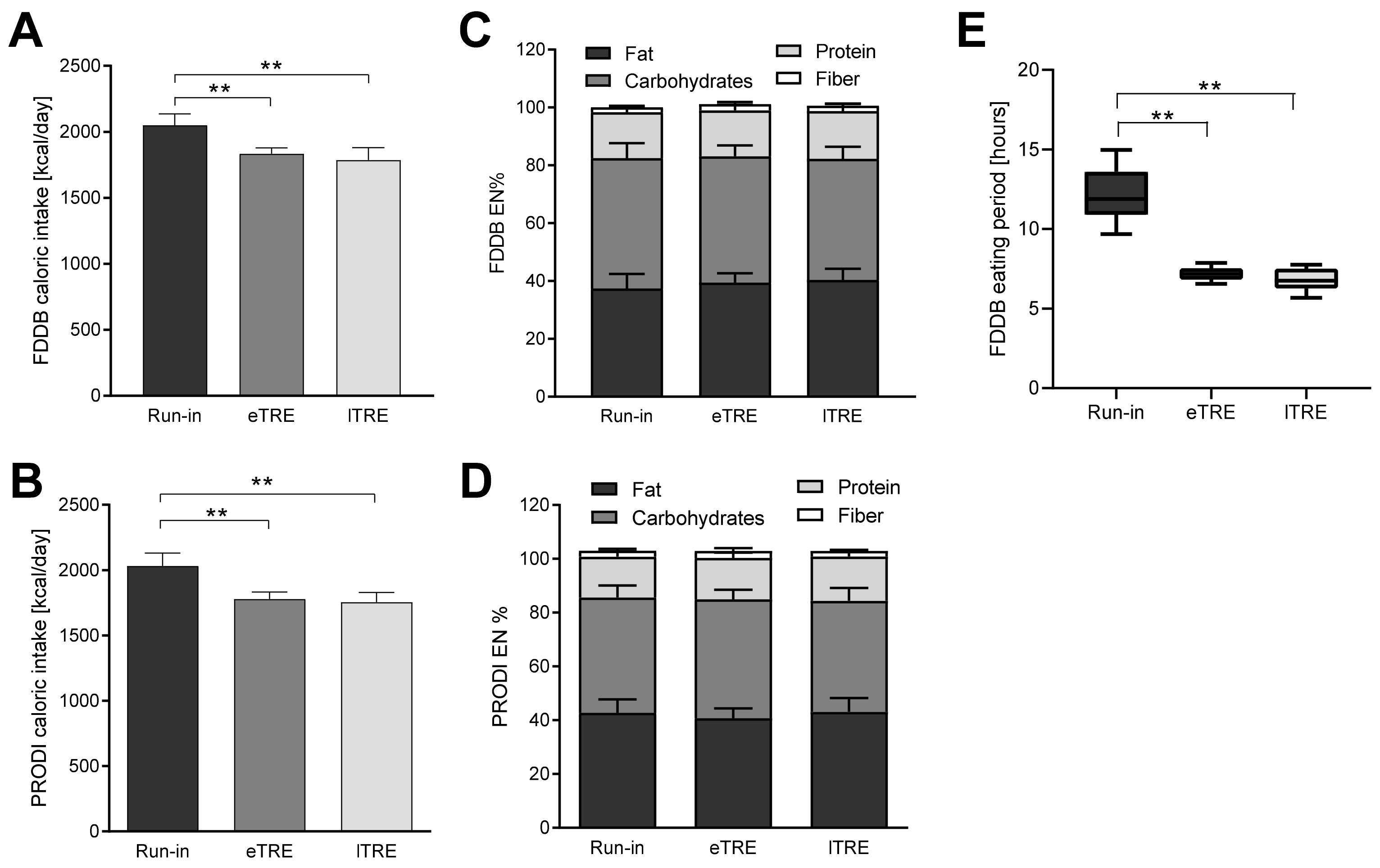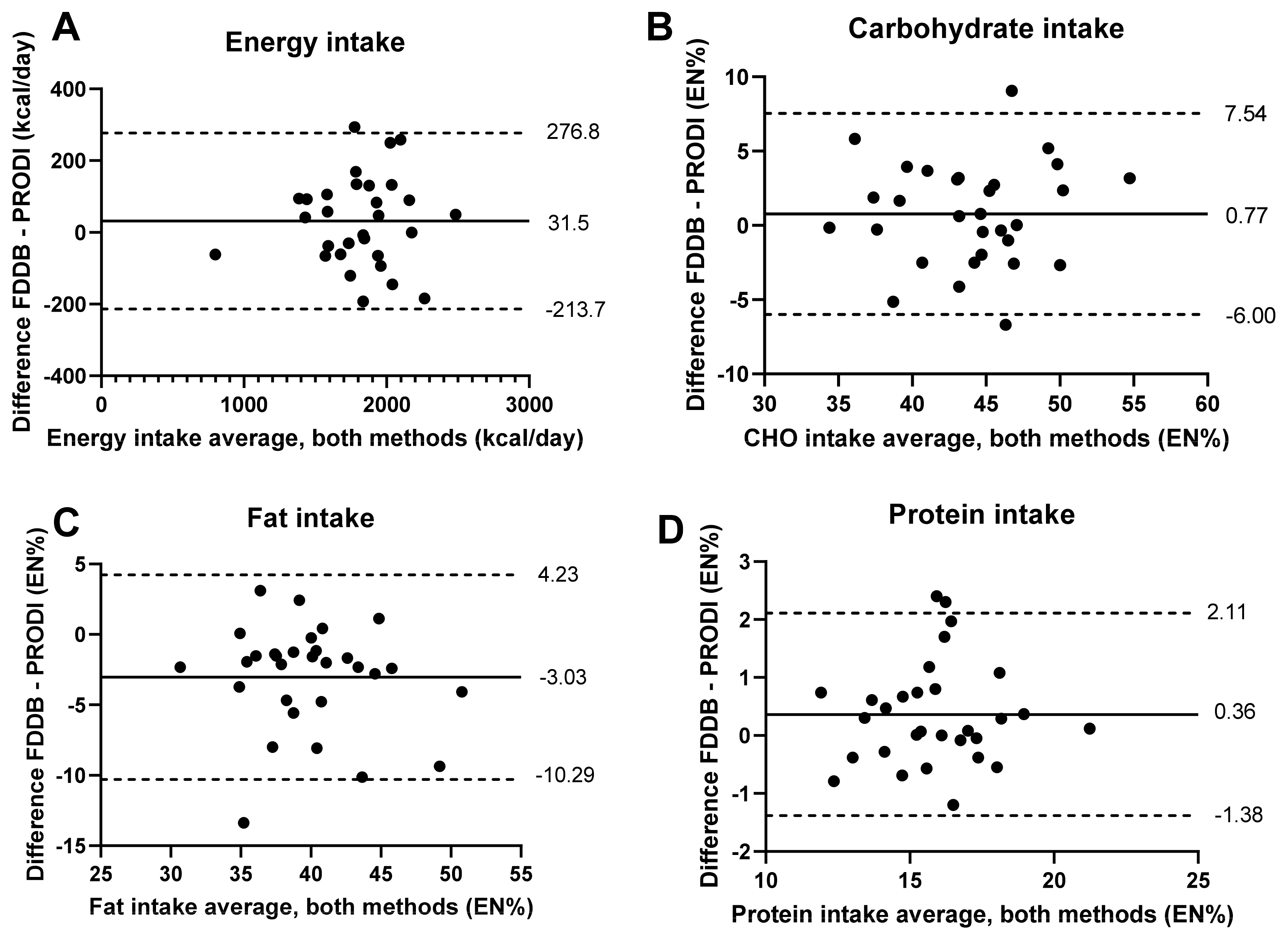Validation of a Smartphone Application for the Assessment of Dietary Compliance in an Intermittent Fasting Trial
Abstract
:1. Introduction
2. Materials and Methods
2.1. Study Design
2.2. Study Participants and Anthropometric Measurements
2.3. Food Intake Documentation and Nutrient Analysis
2.4. FDDB Extender App and Food Database
2.5. PRODI® Software
2.6. Statistical Analysis
3. Results
3.1. Participant Characteristics
3.2. Energy and Macronutrient Intakes at Baseline and during the TRE Periods
3.3. Comparison of the FDDB Tool with PRODI® Software
4. Discussion
5. Conclusions
Author Contributions
Funding
Institutional Review Board Statement
Informed Consent Statement
Acknowledgments
Conflicts of Interest
References
- Carter, M.C.; Burley, V.J.; Nykjaer, C.; Cade, J.E. ‘My Meal Mate’ (MMM): Validation of the diet measures captured on a smartphone application to facilitate weight loss. Br. J. Nutr. 2013, 109, 539–546. [Google Scholar] [CrossRef]
- Hutchesson, M.J.; Rollo, M.E.; Callister, R.; Collins, C.E. Self-monitoring of dietary intake by young women: Online food records completed on computer or smartphone are as accurate as paper-based food records but more acceptable. J. Acad. Nutr. Diet. 2015, 115, 87–94. [Google Scholar] [CrossRef]
- Sharp, D.B.; Allman-Farinelli, M. Feasibility and validity of mobile phones to assess dietary intake. Nutrition 2014, 30, 1257–1266. [Google Scholar] [CrossRef] [PubMed]
- Smartphone Users by Country Worldwide 2021. Published by Statista Research Department. 11 August 2022. Available online: https://www.statista.com/statistics/748053/worldwide-top-countries-smartphone-users/ (accessed on 4 July 2022).
- Share of Smartphone Users in Germany 2021, by Age Group. Published by Evgenia Koptyug, 14 December 2021. Available online: https://www.statista.com/statistics/469969/share-of-smartphone-users-in-germany-by-age-group/ (accessed on 4 July 2022).
- Schuppelius, B.; Peters, B.; Ottawa, A.; Pivovarova-Ramich, O. Time Restricted Eating: A Dietary Strategy to Prevent and Treat Metabolic Disturbances. Front. Endocrinol. 2021, 12, 683140. [Google Scholar] [CrossRef]
- Varady, K.A.; Cienfuegos, S.; Ezpeleta, M.; Gabel, K. Clinical application of intermittent fasting for weight loss: Progress and future directions. Nat. Rev. Endocrinol. 2022, 18, 309–321. [Google Scholar] [CrossRef]
- Gill, S.; Panda, S. A Smartphone App Reveals Erratic Diurnal Eating Patterns in Humans that Can Be Modulated for Health Benefits. Cell Metab. 2015, 22, 789–798. [Google Scholar] [CrossRef]
- Holzmann, S.L.; Pröll, K.; Hauner, H.; Holzapfel, C. Nutrition apps: Quality and limitations. An explorative investigation on the basis of selected apps. Ernährungs Umsch. 2017, 64, 80–89. [Google Scholar]
- Peters, B.; Koppold-Liebscher, D.A.; Schuppelius, B.; Steckhan, N.; Pfeiffer, A.F.H.; Kramer, A.; Michalsen, A.; Pivovarova-Ramich, O. Effects of Early vs. Late Time-Restricted Eating on Cardiometabolic Health, Inflammation, and Sleep in Overweight and Obese Women: A Study Protocol for the ChronoFast Trial. Front. Nutr. 2021, 8, 765543. [Google Scholar] [CrossRef]
- Bland, J.M.; Altman, D.G. Statistical methods for assessing agreement between two methods of clinical measurement. Lancet 1986, 1, 307–310. [Google Scholar] [CrossRef]
- Bland, J.M.; Altman, D.G. Agreement between methods of measurement with multiple observations per individual. J. Biopharm. Stat. 2007, 17, 571–582. [Google Scholar] [CrossRef]
- Isenmann, E.; Dissemond, J.; Geisler, S. The Effects of a Macronutrient-Based Diet and Time-Restricted Feeding (16:8) on Body Composition in Physically Active Individuals-A 14-Week Randomised Controlled Trial. Nutrients 2021, 13, 3122. [Google Scholar] [CrossRef]
- Rangan, A.M.; O’Connor, S.; Giannelli, V.; Yap, M.L.; Tang, L.M.; Roy, R.; Louie, J.C.; Hebden, L.; Kay, J.; Allman-Farinelli, M. Electronic Dietary Intake Assessment (e-DIA): Comparison of a Mobile Phone Digital Entry App for Dietary Data Collection With 24-Hour Dietary Recalls. JMIR Mhealth Uhealth 2015, 3, e98. [Google Scholar] [CrossRef]
- Ambrosini, G.L.; Hurworth, M.; Giglia, R.; Trapp, G.; Strauss, P. Feasibility of a commercial smartphone application for dietary assessment in epidemiological research and comparison with 24-h dietary recalls. Nutr. J. 2018, 17, 5. [Google Scholar] [CrossRef]
- Benedik, E.; Korousic Seljak, B.; Hribar, M.; Rogelj, I.; Bratanic, B.; Orel, R.; Fidler Mis, N. Comparison of a Web-Based Dietary Assessment Tool with Software for the Evaluation of Dietary Records. Zdr. Varst. 2015, 54, 91–97. [Google Scholar] [CrossRef]
- Raatz, S.K.; Scheett, A.J.; Johnson, L.K.; Jahns, L. Validity of electronic diet recording nutrient estimates compared to dietitian analysis of diet records: Randomized controlled trial. J. Med. Internet Res. 2015, 17, e21. [Google Scholar] [CrossRef]
- Ahmed, M.; Mandic, I.; Lou, W.; Goodman, L.; Jacobs, I.; L’Abbe, M.R. Validation of a Tablet Application for Assessing Dietary Intakes Compared with the Measured Food Intake/Food Waste Method in Military Personnel Consuming Field Rations. Nutrients 2017, 9, 200. [Google Scholar] [CrossRef]
- Ji, Y.; Plourde, H.; Bouzo, V.; Kilgour, R.D.; Cohen, T.R. Validity and Usability of a Smartphone Image-Based Dietary Assessment App Compared to 3-Day Food Diaries in Assessing Dietary Intake Among Canadian Adults: Randomized Controlled Trial. JMIR Mhealth Uhealth 2020, 8, e16953. [Google Scholar] [CrossRef]
- Livingstone, M.B.; Black, A.E. Markers of the validity of reported energy intake. J. Nutr. 2003, 133 (Suppl. 3), 895S–920S. [Google Scholar] [CrossRef]
- Illner, A.K.; Freisling, H.; Boeing, H.; Huybrechts, I.; Crispim, S.P.; Slimani, N. Review and evaluation of innovative technologies for measuring diet in nutritional epidemiology. Int. J. Epidemiol. 2012, 41, 1187–1203. [Google Scholar] [CrossRef]
- Wilkinson, M.J.; Manoogian, E.N.C.; Zadourian, A.; Lo, H.; Fakhouri, S.; Shoghi, A.; Wang, X.; Fleischer, J.G.; Navlakha, S.; Panda, S.; et al. Ten-Hour Time-Restricted Eating Reduces Weight, Blood Pressure, and Atherogenic Lipids in Patients with Metabolic Syndrome. Cell Metab. 2020, 31, 92–104.e105. [Google Scholar] [CrossRef]
- Acharya, S.D.; Elci, O.U.; Sereika, S.M.; Styn, M.A.; Burke, L.E. Using a personal digital assistant for self-monitoring influences diet quality in comparison to a standard paper record among overweight/obese adults. J. Am. Diet. Assoc. 2011, 111, 583–588. [Google Scholar] [CrossRef] [PubMed] [Green Version]


| Characteristics | n = 10 |
|---|---|
| Age (year) | 61.4 ± 7.1 |
| Gender (male/female) | 0/10 |
| Height (cm) | 162 ± 7 |
| Weight (kg) | 82.7 ± 10.3 |
| BMI (kg/m2) | 31.4 ± 2.7 |
| Waist circumference (cm) | 98.1 ± 10.6 |
| Hip circumference (cm) | 109.8 ± 4.9 |
| Waist-to-hip ratio | 0.89 ± 0.09 |
| Body fat (%) | 40.2 ± 7.9 |
| Nutrients | PRODI | FDDB | Correlation | Difference FDDB vs. PRODI | p-Value * |
|---|---|---|---|---|---|
| Mean ± SD | Mean ± SD | r (p) | Δ% | ||
| Energy (kcal) | 1796 ± 328 | 1827 ± 328 | 0.926 (2.27 × 10−13) | 17.6 | 0.178 |
| Protein (g) | 66.9 ± 13.7 | 69.5 ± 13.3 | 0.921 (5.36 × 10−13) | 3.9 | 0.014 |
| Protein (EN%) | 15.7 ± 2.0 | 16.0 ± 2.1 | 0.907 (5.26 × 10−12) | 2.3 | 0.033 |
| Carbohydrates (g) | 185.6 ± 34.5 | 191.9 ± 39.8 | 0.929 (1.31 × 10−13) | 3.3 | 0.031 |
| Carbohydrates (EN%) | 43.6 ± 4.9 | 44.4 ± 5.1 | 0.759 (1.17 × 10−6) | 1.8 | 0.231 |
| Fat (g) | 80.8 ± 20.0 | 78.1 ± 18.0 | 0.849 (2.96 × 10−9) | −3.4 | 0.166 |
| Fat (EN%) | 41.4 ± 5.0 | 38.4 ± 4.5 | 0.699 (1.71 × 10−5) | −7.3 | 1.07 × 10−4 |
| Saturated fat (g) | 34.7 ± 9.0 | 20.7 ± 7.6 | 0.532 (0.003) | −40.3 | 5.04 × 10−10 |
| Cholesterol (mg) | 317 ± 90 | 124 ± 49 | 0.625 (2.21 × 10−4) | −61.1 | 3.87 × 10−15 |
| Fiber (g) | 20.7 ± 7.2 | 17.8 ± 6.8 | 0.745 (2.29 × 10−6) | −13.6 | 0.002 |
| Alcohol (g) | 0.90 ± 1.62 | 4.93 ± 23.69 | 0.527 (2.77 × 10−3) | 448 | 0.014 |
| Sugar (g) | 79.0 ± 23.0 | 70.9 ± 22.9 | 0.893 (3.39 × 10−11) | −10.3 | 2.35 × 10−4 |
| Salt (g) | 5.74 ± 1.74 | 4.91 ± 1.79 | 0.754 (3.63 × 10−6) | −14.5 | 5.88 × 10−4 |
| Vitamin A (mg) | 0.75 ± 0.66 | 1.33 ± 2.56 | 0.317 (0.088) | 76.0 | 0.805 |
| Vitamin D (µg) | 3.53 ± 3.06 | 1.32 ± 0.81 | 0.500 (0.005) | −62.6 | 4.07 × 10−5 |
| Vitamin E (mg) | 11.60 ± 3.65 | 6.29 ± 5.86 | 0.725 (5.85 × 10−6) | −45.8 | 4.14 × 10−9 |
| Vitamin B1 (mg) | 1.05 ± 0.29 | 0.60 ± 0.38 | 0.455 (0.012) | −42.9 | 2.59 × 10−5 |
| Vitamin B2 (mg) | 1.19 ± 0.34 | 0.89 ± 0.51 | 0.554 (0.002) | −26.1 | 3.45 × 10−4 |
| Vitamin B6 (mg) | 1.28 ± 0.39 | 1.50 ± 1.66 | 0.590 (0.001) | 17.2 | 8.04 × 10−2 |
| Vitamin B12 (µg) | 4.42 ± 1.85 | 2.16 ± 1.33 | 0.378 (0.039) | −51.1 | 6.55 × 10−9 |
| Vitamin C (mg) | 90.7 ± 50.8 | 82.9 ± 55.7 | 0.697 (1.91 × 10−5) | −8.6 | 0.017 |
| Potassium (mg) | 2568 ± 735 | 1418 ± 652 | 0.835 (9.66 × 10−9) | −44.8 | 3.57 × 10−14 |
| Magnesium (mg) | 287 ± 79 | 137 ± 66 | 0.835 (9.66 × 10−9) | −52.3 | 1.49 × 10−15 |
| Calcium (mg) | 598 ± 150 | 360 ± 156 | 0.679 (3.71 × 10−5) | −39.8 | 1.68 × 10−11 |
| Iron (mg) | 11.84 ± 3.30 | 4.95 ± 2.42 | 0.749 (1.88 × 10−6) | −58.2 | 9.15 × 10−16 |
| Phosphorus (mg) | 1080 ± 239 | 498 ± 226 | 0.624 (2.28 × 10−4) | −53.9 | 9.19 × 10−16 |
| Copper (mg) | 1708 ± 502 | 1184 ± 1519 | 0.272 (0.146) | −30.7 | 5.71 × 10−4 |
| Zinc (mg) | 8.82 ± 2.01 | 3.89 ± 1.81 | 0.539 (2.10 × 10−3) | −55.9 | 1.73 × 10−6 |
| Chloride (mg) | 4989 ± 4506 | 1338 ± 968 | 0.618 (2.75 × 10−4) | −73.2 | 1.73 × 10−6 |
| Fluoride (mg) | 586 ± 408 | 1024 ±1824 | 0.427 (0.019) | 74.8 | 0.237 |
| Iodide (µg) | 63.3 ± 25.9 | 94.9 ± 302.1 | 0.414 (0.023) | 50.0 | 4.90 × 10−4 |
| Manganese (mg) | 4447 ± 2312 | 2069 ± 1600 | 0.711 (1.06 × 10−5) | −53.5 | 1.73 × 10−6 |
| Sulfur (g) | 645 ± 272 | 226 ± 139 | 0.667 (5.74 × 10−5) | 64.9 | 1.73 × 10−6 |
Publisher’s Note: MDPI stays neutral with regard to jurisdictional claims in published maps and institutional affiliations. |
© 2022 by the authors. Licensee MDPI, Basel, Switzerland. This article is an open access article distributed under the terms and conditions of the Creative Commons Attribution (CC BY) license (https://creativecommons.org/licenses/by/4.0/).
Share and Cite
Baum Martinez, I.; Peters, B.; Schwarz, J.; Schuppelius, B.; Steckhan, N.; Koppold-Liebscher, D.A.; Michalsen, A.; Pivovarova-Ramich, O. Validation of a Smartphone Application for the Assessment of Dietary Compliance in an Intermittent Fasting Trial. Nutrients 2022, 14, 3697. https://doi.org/10.3390/nu14183697
Baum Martinez I, Peters B, Schwarz J, Schuppelius B, Steckhan N, Koppold-Liebscher DA, Michalsen A, Pivovarova-Ramich O. Validation of a Smartphone Application for the Assessment of Dietary Compliance in an Intermittent Fasting Trial. Nutrients. 2022; 14(18):3697. https://doi.org/10.3390/nu14183697
Chicago/Turabian StyleBaum Martinez, Isabella, Beeke Peters, Julia Schwarz, Bettina Schuppelius, Nico Steckhan, Daniela A. Koppold-Liebscher, Andreas Michalsen, and Olga Pivovarova-Ramich. 2022. "Validation of a Smartphone Application for the Assessment of Dietary Compliance in an Intermittent Fasting Trial" Nutrients 14, no. 18: 3697. https://doi.org/10.3390/nu14183697
APA StyleBaum Martinez, I., Peters, B., Schwarz, J., Schuppelius, B., Steckhan, N., Koppold-Liebscher, D. A., Michalsen, A., & Pivovarova-Ramich, O. (2022). Validation of a Smartphone Application for the Assessment of Dietary Compliance in an Intermittent Fasting Trial. Nutrients, 14(18), 3697. https://doi.org/10.3390/nu14183697





.png)

